
Casting : Hot Heap

Years of Production
1968-1970
Country of Origin
US and HK
Casting Variations
US vs. HK production, Detailed Below
US Exhaust Pipe Variations
Interior Colors:
US Interior Colors: White/Cream, Champagne and Dark Brownw
HK Interior Colors: White/Cream, Tan/Grey, Dark Brown
US - Clear Glass, Normal and "Bent Windshield"
HK - Blue Glass
Color chart
| US
COLORS: |
COMMENTS: |
| antifreeze | very common |
| green | very common |
| aqua | common |
| blue | common |
| gold | common |
| lime | common |
| orange | common |
| purple | common |
| red | common |
| copper | uncommon |
| hot pink |
uncommon |
| olive green |
uncommon |
| light (apple) green |
hard to find |
| magenta |
hard to find |
| rose |
hard to find |
| creamy pink |
very hard to find |
| light blue | very hard to find |
| olive gold |
very hard to find |
| yellow | very hard to find |
| brown (dark or chocolate) |
very rare |
| HK COLORS: |
COMMENTS: |
| blue | very common |
| green | very common |
| red | very common |
| aqua |
common |
| brown |
uncommon |
| orange |
uncommon |
| purple |
uncommon |
| copper |
hard to find |
| creamy pink |
hard to find, esp. in the US |
Comments:
The Hot Heap is based on the Ford Model T.

Tognotti's King T Showcar
The "King T" is a 1913 Ford Model T Roadster owned by Don Tognotti of Sacramento, California. The car was built by Don and Gene Winfield of Winfield's Custom
Shop, starting in July of 1962, and completed in 1964. It was shown at the 1964 National Roadster Show, where it won the America's Most Beautiful Roadster award.
It is unusual to see a real T-bucket roadster with all the fenders still attached! It sold in 2010 for over $80,000!

1968 Hot Heap: US (L) : Hong Kong (R)
The body castings of the two versions of the Hot Heaps are similar but the differences in the size of the "bucket" and the sweeping angle of the fenders is noticeable.
Most all Hot heaps have bearing type wheel but late run HK models have been found with caps one example of a late run US model with all capped wheels is known.
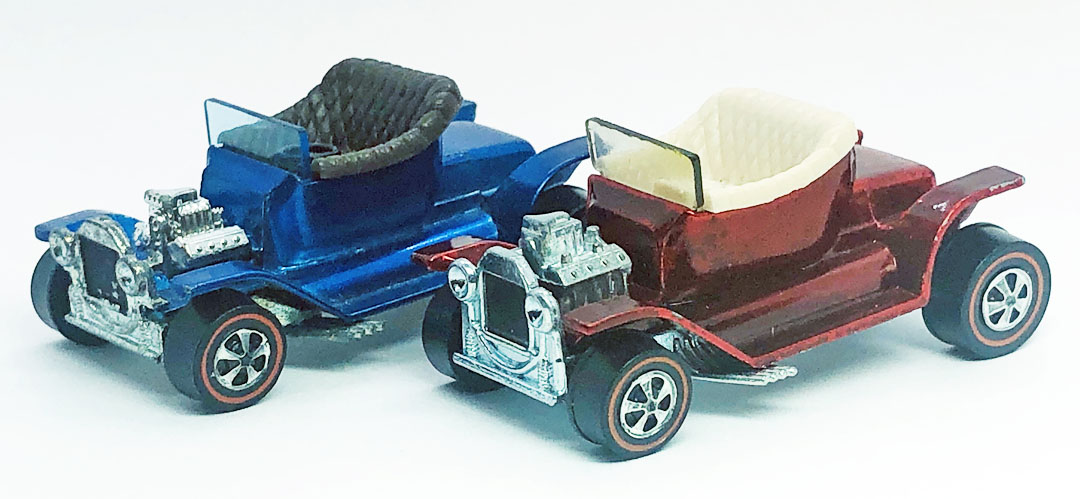
1968 Hong Kong (L) : Hot Heap: US (R)
US interiors are found in white, champagne or bronze, and dark brown. As with other US castings, it appears that dark brown and champagne interiors were phased out
leaving only white interiors on the late run versions. Dark brown interiors are seen much less often and were phased out in 1969. Only white interiors are found on
the late-run color versions like hot pink, magenta, apple green, rose, and true yellow. The color of the interior does not greatly impact the value of the Hot Heap.
The blue glass of the HK casting is evident. All Hot Heaps have flat black paint on the radiator fins. Additional subtle differences are evident through out the two designs.
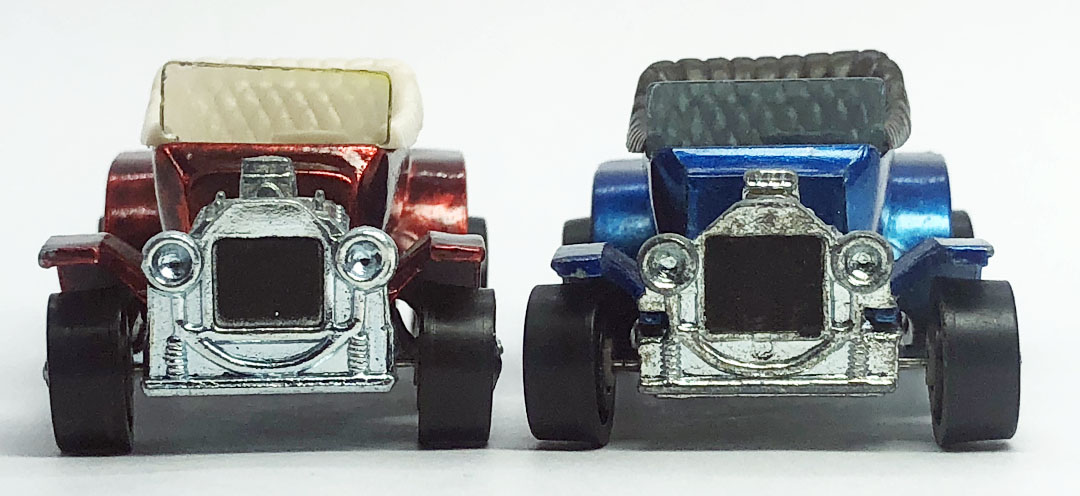
The front grille and headlight section is part of the base on both models. No significant differences are noted.
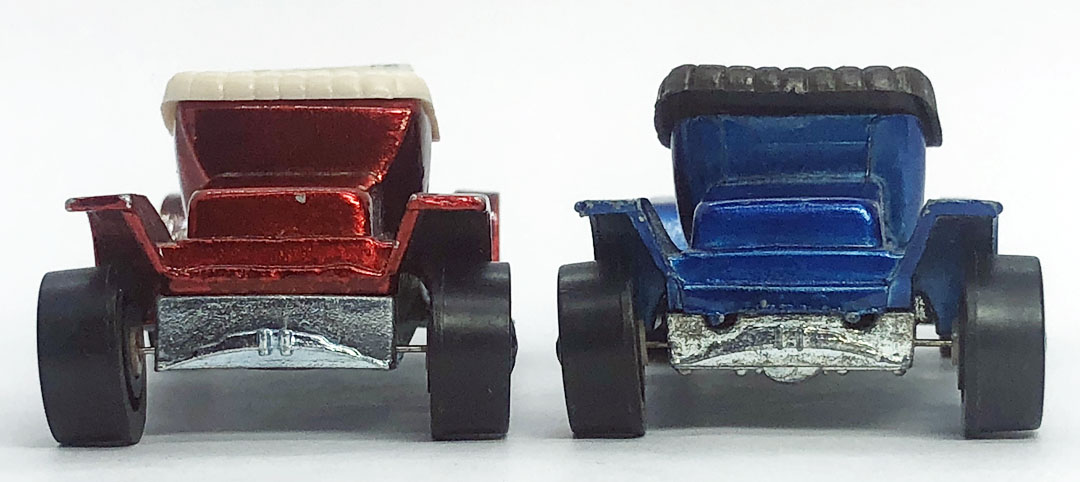
1968 Hot Heap: US (L) : Hong Kong (R)
From the rear, the different shapes of the T Bucket can be seen as well as some differences in the base casting .
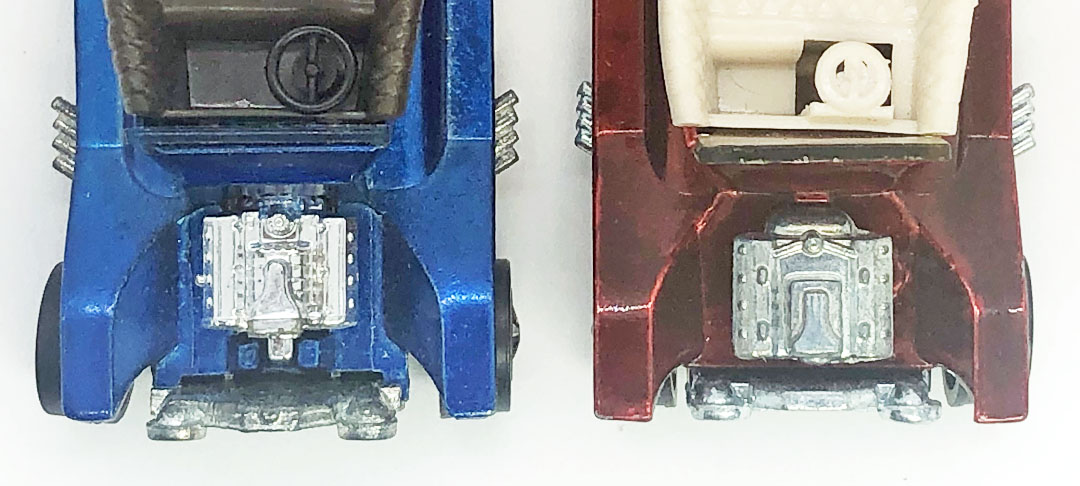
1968 Hong Kong (L) : Hot Heap: US (R)
On the Hong Kong version, the steering wheel is separate part whereas the steering wheel on the US model is molded as part of the dashboard.
The design of the engine compartments differs greatly between the US and HK versions of the Hot Heap. On the Hong Kong variant, the engine is a plastic
insert that is wedged between the body and base during assembly against a sloping firewall and rounded transmission hump. The engine of the US model is
metal and is "spun" underneath acting as the front "rivet", fastening the body to the base. The rear of the engine butts against a small rectangular
block that abuts a more vertical firewall. The rectangular block and the engine position varies slightly with the different revisions of the casting.

US Hot Heap Exhaust Pipe Variations: Revision "A/B" vs. Type "D"
There are 4 distinct side pipe variations among US Hot Heaps. The parts are internally labeled with a letter: (A,B, C or D) to reflect the revision level.
The point where the exhaust pipes leave the base shows the pronounced variation with increasing levels of curvature being evident. The A and B variants
are essentially straight pipes. The D variant shows the most curvature where the C variant is intermediate between the two. The production run of the C
variant was apparently the shortest run as they are the most difficult to find.
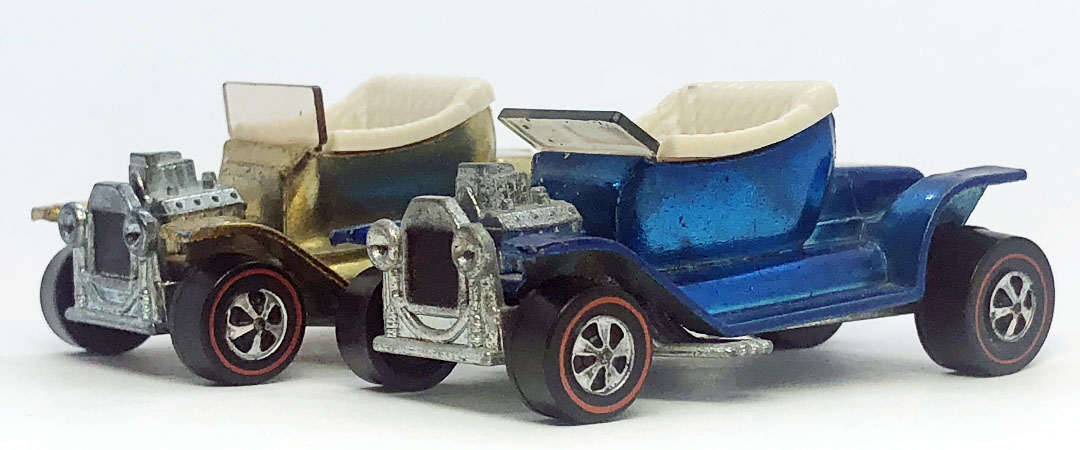
Bent or Tilted Windshield Variant
Early in the 'D' run there appears to have been a large batch of cars assembled with windshields tilted forward at varying degrees. This was explained as having resulted from
the windshield mold sticking at the time of ejection from the tool. However, since the windshields still fit in the cars, they were still used. Tilted window cars
are less common but do not seem to add much value to the car. Some collectors view this as a defect, not a variation.

1968 Hot Heap: US (L) : Hong Kong (R)
The absence of mechanical detail on the US version is typical. It is fastened to the body by the engine rivet in the front and a body rivet in the rear.
The HK casting includes the typical suspension holes and features only one rivet. The front to the car being engineered with a latch of sorts.
There are several variations in the text on the base, especially the trademark circle and exhaust pipes.

Hot Heaps with Uncommon Capped Wheels

1968 Hot Heaps from Hong Kong and US Production
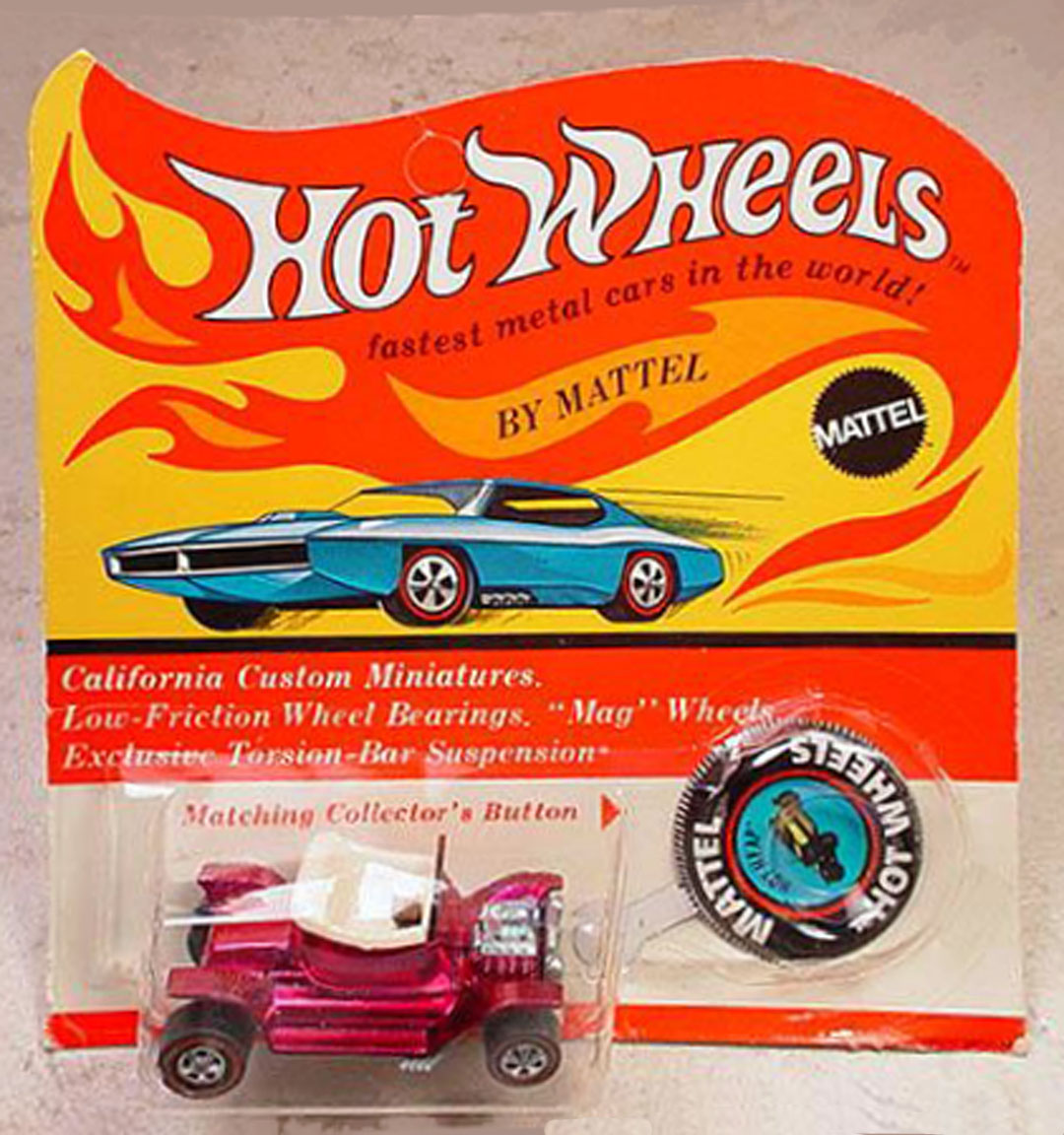
Magenta Hot Heap in Blister Pack
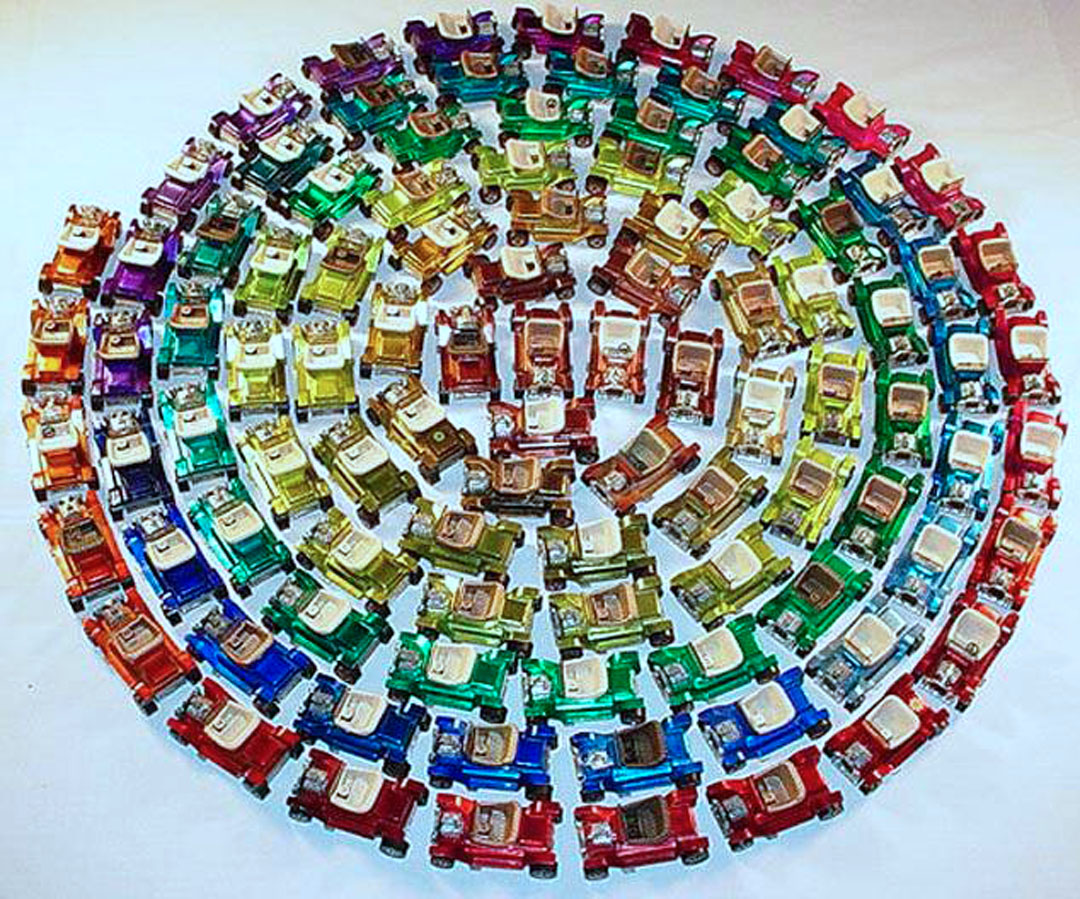
Jerry Schmitt's Unparalleled Circle Of Hot Heaps
PREPRODUCTION
Photo & info credits: Jerry Schmitt, TN Gray
| All |
1968 |
1969 |
1970 |
1971 |
1972 |
1973 |
1974 |
1975 |
1976 |
1977 |
Alphabetical |
| Customs | |
Gran Prix | |
Heavyweights | |
Spoilers | |
Super Chromes | |
Alternate Colors | |
CIPSA | |
Home |

* DISCLAIMER *
Private use of original images is allowed.
Non-profit, non-commercial publication of original images is allowed only with prior expressed written consent from Graymatters.
For other commercial, for-profit or redistribution needs, please contact the site owner. This site is not affiliated with Mattel, Inc.
Questions? ... Send me an e-mail: tngray@nautiloid.net
© 2012 by Graymatters. All Rights Reserved.